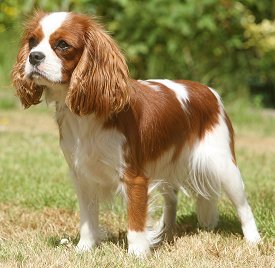 |
| Classic King Charles Spaniels |
Episodic Falling Syndrome (EFS)
EFS is a recessive, genetic condition that is unique to the cavalier breed and has never been diagnosed in any other dog breed. It prevents the muscles from being able to relax, normally instigated by excitement, exercise, or frustration. Symptoms vary for each dog but could include things such as freezing/stiffness, spasms, or being unable to react to stimuli. The dog will not lose consciousness. The condition can be improved with therapy and is very rarely life threatening. Most dogs will carry on without any reaction after a mild episode and will become used to the incidents over time. There is no official cure for EFS but a study carried out in 2002 showed cavaliers with EFS improved dramatically when given a drug called clonazepam. After being given the medication for two years they were described as being almost completely cured. However, it has been suggested that being given this drug for an extended period of time can result in tolerance of the drug, causing it to lose effectiveness.
Hip dysplasia
Hip dysplasia is a degenerative disease which can develop in any dog breed. A degenerative disease is one which will get worse with age, however it can also be affected by weight and volume of exercise. Any dog may develop hip dysplasia, however, it is a partially inherited disorder as it is more likely to occur in dogs that have been bred from parents who also suffered from hip dysplasia. Puppies will not be born with the condition, it will develop as they age. About 10% of cavaliers are diagnosed by two years old. It can cause varying degrees of arthritis and is thought to affect 12-24% of cavaliers. However, some people believe that it may be higher than this as, once the dog reaches a certain age, it will probably be diagnosed as arthritis. It can only be diagnosed accurately with an x-ray. Once diagnosed, a dog will probably be given medication to limit the pain and help increase mobility. If this is not effective then surgery may be considered.
Mitral Valve Disease (MVD)
MVD is thought to be the leading cause of death in cavalier spaniels. It is a poly-genetic disease which means it can be caused by more than one gene and the genes responsible for MVD have yet to be identified. It affects over half of the breed by the age of five and will be present in nearly every cavalier spaniel by the age of ten. It is about 20 times more common in CKCS than other breeds of dogs. MVD is a condition that causes the degeneration of the mitral valve in the heart. This valve usually prevents any back flow when blood is pumped through the heart. MVD results in the back-flow of blood, resulting in less blood being pumped round the body. This causes symptoms such as breathlessness, a distended abdomen, lack of appetite, restlessness, weight loss, and possibly fainting. All cavaliers should be screened for a heart murmur once a year from one year old. Eventually the mitral valve will deteriorate and collapse completely, inevitably resulting in death by chronic heart failure.


No comments:
Post a Comment